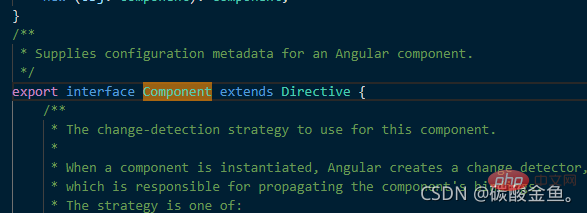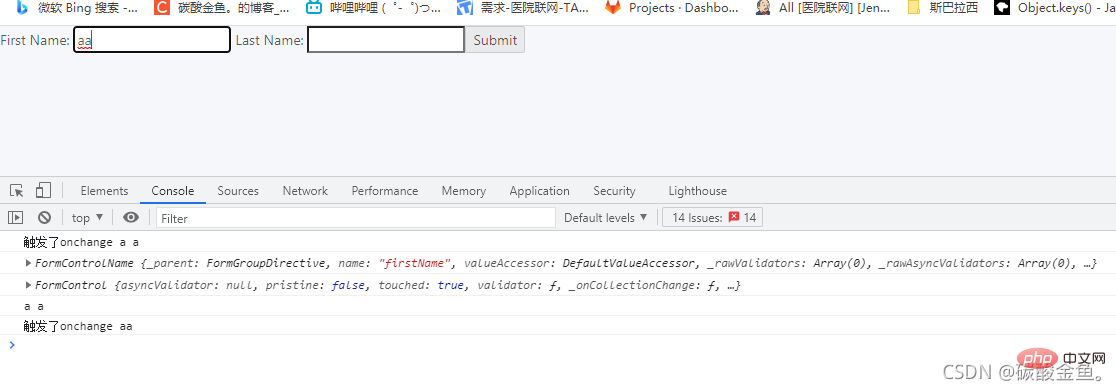浅谈angular中的三种类型指令:组件型、结构型、属性型
- 青灯夜游转载
- 2021-10-15 10:35:413701浏览
本篇文章带大家了解一下angular中的指令,介绍一下组件型指令、结构型指令、属性型指令三种类型的指令,希望对大家有所帮助!

在 Angular 中有三种类型的指令:
- 组件型指令 — 组件是特殊存在,拥有模板
- 结构型指令 — 通过添加和移除 DOM 元素改变 DOM 布局的指令,常用的有:
*ngIf,*ngFor,ngSwitch - 属性型指令 — 改变元素、组件或其它指令的外观和行为的指令,常用的有:
NgClass,NgStyle
【相关教程推荐:《angular教程》】
angular 指令——https://angular.cn/guide/built-in-directives
组件型指令
在查看angular源代码时,会看到如下

所以说组件是继承指令的,只是它比较特殊,有模版
同样,因为组件继承指令,在下面属性型和结构型指令的一系列操作,在组件中都是可以实现的
但是因为指令的目的是为了复用,在组件中这样操作是达不到这个目的,所以强烈不推荐这样去操作.
属性型指令
上面说道属性型指令是用来改变元素、组件或其它指令的外观和行为
那么我们如何打造属于自己的属性型指令呢?
首先,创建指令很像创建组件。
- 导入
Directive装饰器 - 导入符号
Input、TemplateRef和ViewContainerRef,视指令类型与需求来选择 - 给指令类添加装饰器。
- 设置
CSS属性选择器 ,以便在模板中标识出这个指令该应用于哪个元素。
自定义属性型指令
1、创建属性型指令appHighlight指令:highlight.directive.ts
// 1、导入 Directive 装饰器
// 3、导入 ElementRef。ElementRef 的 nativeElement 属性会提供对宿主 DOM 元素的直接访问权限
import { Directive, ElementRef } from '@angular/core';
// 2、@Directive() 装饰器的 selector 属性会指定指令的 CSS 属性选择器 [appHighlight]
@Directive({
selector: '[appHighlight]'
})
export class HighlightDirective {
// 4、构造函数中使用 ElementRef 来注入宿主 DOM 元素的引用
constructor(el: ElementRef) {
// 将对应元素的背景颜色设置为 黄色
el.nativeElement.style.backgroundColor = 'yellow';
}
}与
component和pipe一样,directive也需要在declarations数组中声明才能使用
2、宿主元素用法
<p appHighlight>Highlight me!</p>
处理用户事件
下面指令的功能为:
能够接收2个参数,其中一个为另外一个的默认值
监听宿主元素的鼠标进入和离开事件,在进入时宿主背景颜色为上述传入的值
import { Directive, ElementRef, HostListener, Input } from '@angular/core';
@Directive({
//指定指令的属性型选择器
selector: '[appHighlight]'
})
export class HighlightDirective {
@Input('appHighlight') highlightColor: string;
@Input() defaultColor: string;
//构造函数中使用 ElementRef 来注入宿主 DOM 元素的引用
constructor(private el: ElementRef) { }
//监听宿主元素 mousenter 事件
@HostListener('mouseenter') onMouseEnter() {
this.highlight(this.highlightColor || this.defaultColor);
}
//监听宿主元素 mouseleave 事件
@HostListener('mouseleave') onMouseLeave() {
this.highlight(null);
}
// 修改背景颜色
private highlight(color: string) {
//ElementRef通过其 nativeElement 属性,提供直接访问宿主 DOM 元素的能力。
this.el.nativeElement.style.backgroundColor = color;
}
}宿主元素用法
<p appHighlight="red" defaultColor="black">宿主元素</p>
结构型指令
结构型指令的职责是 HTML 布局。 它们塑造或重塑 DOM 的结构,这通常是通过添加、移除和操纵它们所附加到的宿主元素来实现的。
常见内置结构性指令:
-
NgIf—— 从模板中创建或销毁子视图。 -
NgFor—— 为列表中的每个条目重复渲染一个节点。 -
NgSwitch—— 一组在备用视图之间切换的指令。具体使用方法查看官网
自定义结构性指令
其效果是:
- 如果条件是假值,并且 Angular 以前尚未创建视图,则此 setter 会导致视图容器从模板创建出嵌入式视图。
如果条件为真值,并且当前正显示着视图,则此 setter 会清除容器,这会导致销毁该视图。
1、创建指令ts文件:unless.directive.ts
// 1、导入 Input、TemplateRef 和 ViewContainerRef
import { Directive, Input, TemplateRef, ViewContainerRef } from '@angular/core';
// 2、添加 Directive 装饰器
@Directive({ selector: '[appUnless]'})
export class UnlessDirective {
private hasView = false;
// 3、在指令的构造函数中将 TemplateRef 和 ViewContainerRef 注入成私有变量。
constructor(
private templateRef: TemplateRef<any>,
private viewContainer: ViewContainerRef
) { }
// 4、添加一个带 setter 的 @Input() 属性 appUnless
@Input() set appUnless(condition: boolean) {
// 如果条件是假值,并且 Angular 以前尚未创建视图,则此 setter 会导致视图容器从模板创建出嵌入式视图。
if (!condition && !this.hasView) {
this.viewContainer.createEmbeddedView(this.templateRef);
this.hasView = true;
} else if (condition && this.hasView) {
// 如果条件为真值,并且当前正显示着视图,则清除容器,这会导致销毁该视图。
this.viewContainer.clear();
this.hasView = false;
}
}
}2、测试指令
4ec052f187306610ed12f85860bb3edbShow this sentence unless the condition is true.94b3e26ee717c64999d7867364b1b4a3
结构型指令(例如
*ngIf)上的星号 * 语法是 Angular 解释为较长形式的简写形式。 Angular 将结构型指令前面的星号转换为围绕宿主元素及其后代的6efee24582b35a5bc3ecd0628f23f6da。
例如:*ngIf
<div *ngIf="hero" class="name">{{hero.name}}</div>会被转换为
<ng-template [ngIf]="hero">
<div class="name">{{hero.name}}</div>
</ng-template>Angular 不会创建真正的 6efee24582b35a5bc3ecd0628f23f6da 元素,只会将 e388a4556c0f65e1904146cc1a846bee 和注释节点占位符渲染到 DOM 中
自定义指令例详
下面的指令会去掉input输入框中的所有空格
import { Component, Directive, HostListener } from '@angular/core'
import { hostElement } from '@angular/core/src/render3/instructions';
import { FormGroup, FormControl, Validators, NgControl } from '@angular/forms'
@Component({
selector: "app-test",
templateUrl: "./test.component.html",
// declarations: [TestDirective]
})
export class TestComponent {
constructor() {}
ngOninit() {}
firstName = '';
lastName = '';
profileForm = new FormGroup({
firstName: new FormControl('aa', [Validators.required,Validators.pattern('[a-zA-Z0-9]*')]),
lastName: new FormControl('', Validators.required),
});
onchange(event) {
console.log('触发了onchange', this.firstName)
}
}
@Directive({
selector: '[testDirective]',
// host: {
// 要传递传递事件参数,使用这种方法,不用的可以使用下面的 @HostListener 方法
// '(keyup)': 'onkeyup($event)',
// }
})
export class TestDirective {
constructor(public ngControl: NgControl) {}
ngOnInit() {}
// onkeyup(event) {
@HostListener('keyup') onkeyup(event) {
// console.log("event", event) // 事件参数
console.log(this.ngControl)
console.log(this.ngControl.control)
console.log(this.ngControl.control.value)
if(/\s+/g.test(this.ngControl.control.value)) {
// 只读属性,要通过 setValue 修改
// this.ngControl.control.value = this.ngControl.control.value.replace(/\s+/g, '')
this.ngControl.control.setValue(this.ngControl.control.value.replace(/\s+/g, ''))
}
}
}使用:
<form action="" [formGroup] = 'profileForm'>
<label>
First Name: <input type="text" testDirective formControlName="firstName" [(ngModel)] = "firstName" (ngModelChange) = "onchange($event)">
</label>
<label>
Last Name: <input type="text" testDirective formControlName="lastName">
</label>
<button type="submit" [disabled]="!profileForm.valid">Submit</button>
</form>使用效果

上面的input的初始值为aa,在其中间输入空格字符,首先触发onchange事件,然后在指令触发keyup事件,改变了firstName的值,然后重新触发onchange事件,所以change事件一共触发两次。
更多编程相关知识,请访问:编程入门!!
以上是浅谈angular中的三种类型指令:组件型、结构型、属性型的详细内容。更多信息请关注PHP中文网其他相关文章!

